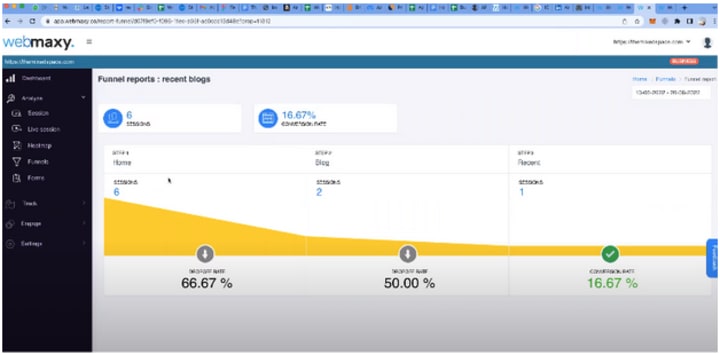6 Steps To Benchmark and Compare Website Traffic Against Your Competitors
Compare Website Traffic

Lucky growth is temporary. Systematic growth is predictable.
To survive amongst your competitor websites and thrive in your industry business, know what must beat.
More specifically, learn to benchmark your website by checking competitor website traffic.
In online business, competitive website benchmarking helps you:
Identify your position in the marketplace.
Provide metrics on why you and your competitors stand at your current place.
How to improve your website for better marketing
Now take a quick glimpse at how to benchmark your website against competitors in 6 simple steps:
- Determine the key performance indicator
- Find the metrics to Benchmark your website.
- Recognize the right competitors
- Benchmark your website
- Track and prepare the report
- Create a customer journey map
Determine The Key Performance Indicator
Using user behavior analytics tools, identify the key performance indicators (KPI) by recognizing your website’s trouble spots and highlights.
Webmaxy’s session recordings, heatmaps, scroll maps, and funnel analysis help you measure the engagement metrics through individual pages and across your website.
Session recordings give you insights on:
- number of sessions per user
- how people scroll through the website
- session duration
- pages viewed per session

An example of the Webmaxy heatmap tool showing visitors clicking pattern
Heatmaps and scroll map visually outline how people interact with an individual page by displaying “hot” and “cold” spots.
In addition, it helps you identify the scrolling and clicking patterns through which you can draw insight into the optimization possibilities.

The funnel analysis report generated using Webmaxy
The funnel analysis feature helps you identify which pages are the most visited and which are causing significant drop-off.
The data obtained on engagement metrics are valuable for understanding what is and isn’t working on your website to identify the KPI.
Find the metrics to Benchmark your website
The engagement metrics you benchmark will change based on your goals. Here are some significant website metrics that are usually benchmarked.
- Page load time
- Average session duration
- Pages per session
- Time on page
- Bounce rate
Out of all this, identify the right metrics based on the drawbacks and weak points of the website.
Then, organize them depending on the urgency. Finally, prioritize one metric at a time to Benchmark your website.
Recognize the right competitors
After finding what metrics to benchmark, the next big question is how to choose the right companies to benchmark your business?
There are two choices to find your business’s right competitors: immediate competitors and industry leaders. But it is also advised to look into the individual metrics of competitors that represent similar KPIs.
Immediate competitors:
When you want to study industry trends and specific topics, it’s best to select your direct competitors offering equivalent products to the same size audience.
Make sure to analyze and measure their performance against yours often.
Industry leaders:
If you want to set long-term goals based on strategies, target high and benchmark yourself to the sites that lead your industry.
Beginning with the best in class and lining all your competitors to the industry leaders helps you develop a comprehensive market map.
Benchmark your website
The engagement metrics you obtained using website analytical tools do not serve enough until you benchmark them with the industry standards or the best-in-class.
The procedure lets you view your overall performance in the industrial market and helps you identify the blind spots.
Take a quick look at the benchmarking tools you can employ to compare website traffic:
Similar Web
Similar Web is a free competitor analysis tool that provides an insider look for creating a solid marketing strategy.
With its premium plan, you can:
Analyze your business against the industry to understand the growth strategy
Conduct company analysis to discover competitor digital strategies
Make audience analysis to learn audience browsing behavior.
Google Analytics
Using Google Analytics’s benchmarking feature, you compare websites data against the average metrics of other industry-specific websites.
Narrow down the results by choosing the country and site size based on everyday traffic volume.
The site size ensures that you compare your business with other sites with roughly the same traffic volume.
Semrush
Semrush is a powerful SEO tool that helps you perform competitor investigations to optimize your campaigns. It has both paid and free features.
The free features of Semrush help you:
- benchmark your website against competitors
- Find your organic search competitors
- Organize the paid search
- Investigate your competitors’ social media.
Semrush has three premium offers: Pro, Guru, and Business.
Track and prepare the report
To maintain things systematised, make separate benchmarking reports for each metric and each competitor.
Establish a routine practice of quarterly benchmarking to ensure the metrics are still relevant. It will stay updated on the industry trends and patterns.
If your business makes any alterations to the existing KPIs, never miss revising the metrics for competitive benchmarking of your website.
Create a customer journey map
If your competitor is better than you in providing what your customers want, identify it as an excellent dimension to experiment with the new strategy.
Using a customer journey map, create a strategical outline for people to navigate your website integrating the data obtained through benchmarking.
Conclusion: Benchmark your website
Benchmarking the website helps you draw a better picture of your growth potential.
But be mindful of resisting the competition of who can come up with prettier website features.
Instead, use these features to understand the industry trends and set benchmark metrics.
Then, develop your website based on these metrics. The best website benchmarking is the one focused on your goals and helps you achieve them.
About the Creator
Adam Wilson
Adam Wilson comes with an experience of 12+ years in the IT industry. As a Customer Success Manager, he has been researching and trying to understand the customers’ behavior in different scenarios.






Comments
There are no comments for this story
Be the first to respond and start the conversation.